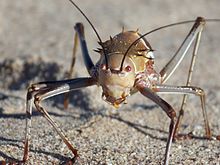Acanthoplus discoidalis
| Acanthoplus discoidalis | ||||||||||||
|---|---|---|---|---|---|---|---|---|---|---|---|---|

Acanthoplus discoidalis |
||||||||||||
| Systematics | ||||||||||||
|
||||||||||||
| Scientific name | ||||||||||||
| Acanthoplus discoidalis | ||||||||||||
| ( Walker , 1869) |
Acanthoplus discoidalis is a long- nose insect (Ensifera) from the family of grasshopper (Tettigonioidea)found in Africa.
features
Acanthoplus discoidalis reaches a body length of about five centimeters. The basic color is gray-brown. The saddle-shaped, armored tergum has several very pointed spines that make the species distinctive. In English usage, it is usually referred to as the Armored Katydid (armored grasshopper). Shorter spines are found on the rest of the body and on the legs. The mandibles are very strong and able to bite even tough, woody material or thick pieces of chitin . The wings have receded to short stumps, so the animals are unable to fly.
Distribution and occurrence
The species occurs in South Africa , Namibia , Botswana and Zimbabwe . Acanthoplus discoidalis prefers to colonize grasslands. It can also be found in the Kalahari and the Namib . It is sometimes harmful on agriculturally used areas and sometimes causes considerable harvest losses on pearl millet fields ( Pennisetum glaucum ).
Way of life
Acanthoplus discoidalis feeds omnivorously . The animals eat the leaves, stems and fruits of various plants, as well as the carcasses of animals. Sometimes they fall on young birds in the nests of the blood-billed weavers ( Quelea quelea ). In case of populations also been cannibalism observed. Horrors run over on country roads are willingly accepted as food by conspecifics. The sexes are polygamous. When mating, the male passes spermatophore along with a spermatophylax to the female. The males prefer not yet mated females, which they recognize by their lighter weight, since then the probability of passing on their own genetic makeup is greatest. The female lays the eggs in groups just below the surface of the earth. At the beginning of the rainy season (in Namibia in January) the larvae hatch from the eggs and initially feed on low-growing grasses. The animals develop parallel to the vegetation and are sexually mature in autumn.
Defense Mechanisms
Acanthoplus discoidalis has a number of defense mechanisms that are used in different ways:
- The entire body with the armored and spiky pronotum as well as the spines on the abdomen and legs should generally protect against potential enemies.
- The very powerful biting tools are used against smaller attackers from the side.
- The males use stridulation as a deterrent by means of noises .
- Sometimes the horrors spew out foul-smelling vomit to drive away the attackers .
- When attacked from above, reflex bleeding is triggered from special glands . The blood can be splashed up to six centimeters high, it is sharp and corrosive and is preferably used against skinks , agamas and birds .
Danger
Acanthoplus discoidalis is widespread in its areas of occurrence, sometimes follows in agricultural areas and is there annually harmful. The species is therefore classified by the World Conservation Organization IUCN as ![]() " least concern = not endangered".
" least concern = not endangered".
Individual evidence
- ↑ Attack on Bloodbeak Weaver
- ↑ The strangest insect of them all (The strangest of all insects)
- ↑ Defense Mechanisms
- ^ IUCN Red List
Web links
- eol.org - Encyclopedia of Life

